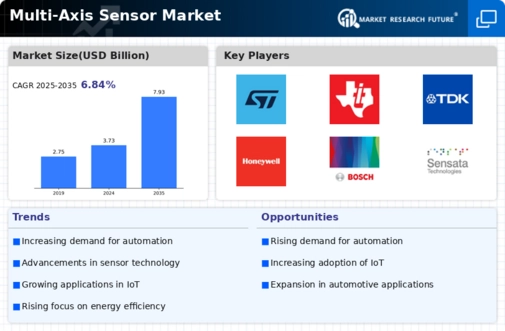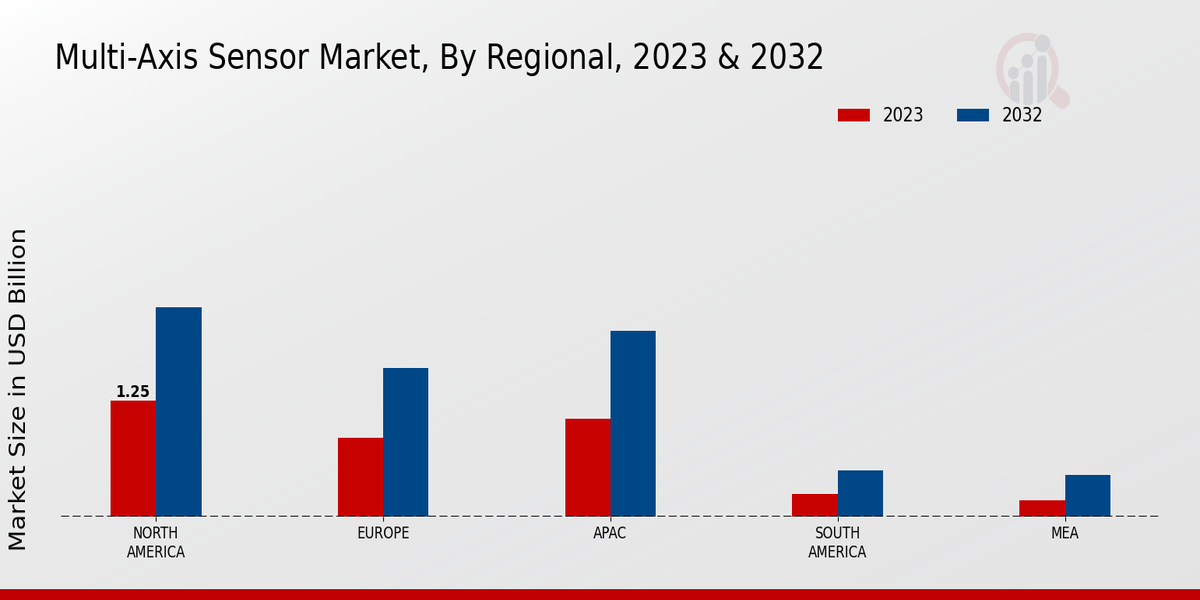Market Growth Projections
The Global Multi-Axis Sensor Market Industry is projected to experience substantial growth, with estimates indicating a market value of 3.73 USD Billion in 2024 and a remarkable increase to 7.93 USD Billion by 2035. This growth trajectory reflects a compound annual growth rate (CAGR) of 7.09% from 2025 to 2035, highlighting the increasing adoption of multi-axis sensors across various sectors. The anticipated expansion is driven by technological advancements, rising demand in automotive and industrial automation, and emerging applications in consumer electronics and healthcare. These projections underscore the market's potential and the ongoing evolution of sensor technology.
Technological Advancements
The Global Multi-Axis Sensor Market Industry is experiencing rapid growth due to continuous technological advancements. Innovations in sensor technology, such as improved sensitivity and miniaturization, are driving demand across various sectors, including automotive, aerospace, and consumer electronics. For instance, the integration of multi-axis sensors in autonomous vehicles enhances navigation and safety features. As a result, the market is projected to reach 3.73 USD Billion in 2024, reflecting a growing reliance on sophisticated sensor systems. This trend indicates that companies are increasingly investing in research and development to enhance sensor capabilities, thereby expanding their market presence.
Rising Demand in Automotive Sector
The automotive sector is a significant driver of the Global Multi-Axis Sensor Market Industry, as manufacturers increasingly incorporate these sensors into vehicles for enhanced performance and safety. Multi-axis sensors facilitate advanced driver-assistance systems (ADAS), which are becoming standard in modern vehicles. The growing emphasis on vehicle safety and automation is likely to propel market growth, with projections indicating a market value of 7.93 USD Billion by 2035. This shift suggests that automotive companies are prioritizing the integration of multi-axis sensors to meet consumer expectations and regulatory standards, thereby fostering a competitive landscape.
Emerging Applications in Healthcare
Emerging applications of multi-axis sensors in the healthcare sector are poised to influence the Global Multi-Axis Sensor Market Industry significantly. These sensors are utilized in medical devices for monitoring patient movements and vital signs, enhancing the accuracy of health assessments. The increasing focus on telemedicine and remote patient monitoring is likely to drive demand for these sensors, as healthcare providers seek innovative solutions to improve patient care. This trend suggests that the healthcare industry is recognizing the value of multi-axis sensors in delivering effective and efficient healthcare services, thereby expanding their market potential.
Growing Consumer Electronics Market
The consumer electronics market is a vital component of the Global Multi-Axis Sensor Market Industry, as these sensors are increasingly integrated into devices such as smartphones, tablets, and wearable technology. The demand for enhanced user experiences drives manufacturers to incorporate multi-axis sensors for features like motion detection and orientation sensing. This trend is indicative of a broader shift towards more interactive and responsive consumer products. As the market evolves, the integration of multi-axis sensors is likely to become more prevalent, contributing to the overall growth of the industry and aligning with consumer expectations for advanced technology.
Increased Adoption in Industrial Automation
The Global Multi-Axis Sensor Market Industry is significantly influenced by the increased adoption of automation in industrial settings. Multi-axis sensors play a crucial role in monitoring and controlling machinery, thereby enhancing operational efficiency and reducing downtime. Industries such as manufacturing and logistics are leveraging these sensors for real-time data collection and analysis. The anticipated compound annual growth rate (CAGR) of 7.09% from 2025 to 2035 underscores the potential for growth in this sector. As industries continue to embrace automation, the demand for multi-axis sensors is expected to rise, reflecting a broader trend towards smart manufacturing.





















Leave a Comment